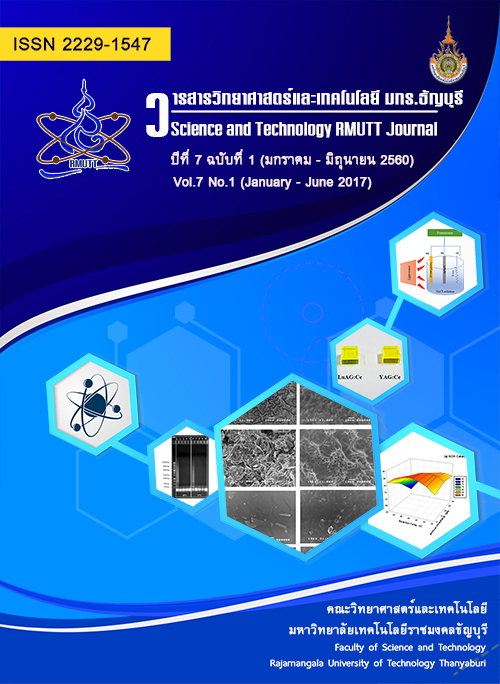Sodium Hypochlorite Production by Photoelectrocatalytic Process Using Composited WO3/BiVO4 Electrodes
Main Article Content
Abstract
In this research, sodium hypochlorite production was studied by the photoelectrocatalytic process under visible light irradiation. WO3 and BiVO4 composited films were deposited on fluorine-doped tin oxide (FTO) conducting glasses by the spin coating technique and used these electrodes for producing sodium hypochlorite in sodium chloride solution. The effect of applied potential, precursor concentration, power of the light source, electrode size and number of electrodes were studied for the optimum condition of the production process. The efficiency of sodium hypochlorite production was monitored by UV-Vis spectrophotometer. As a result, the optimum condition was presented at the applied potential of 2.5 V, 2.0 M of sodium chloride, 28W of visible light source, electrode size 12 cm2 and 3 electrodes which that could produce sodium hypochlorite up to 5,975 ppm for 1 h. Demonstrate that such technique is an attractive option for the production of sodium hypochlorite as savings, fast and efficient compared to traditional chemical techniques.
Article Details
References
H. Vogt, J. Balej, J. E. Bennett, P. Wintzer, S. A. Sheikh, P. Gallone. Chlorine Oxides and Chlorine Oxygen Acids, Ullmann's Encyclopedia of Industrial Chemistry 7 (2007): 2.
M. Spasojevi∗, N. Krstaji, P. Spasojevi, L. R. Zelenovi. Modelling current efficiency in an electrochemical hypochlorite reactor. Chem. Eng. Res. Des. 93 (2015): 591-601.
C. Ponchio, Y. Murakami, S. Kishioka, A. Y. Nosaka and Y. Nosaka. Efficient photocatalytic activity of water oxidation over WO3/BiVO4 composite under light irradiation, Electrochim. Acta, 54 (2009): 1147-1152.
T. Juthamas, C. Ponchio∗, Development of photoelectrocatalysis techniques for phenolic compound degradation under solar light. Sci. & Tech. RMUTT J., 5(1) (2015): 1–8.
C. Ponchio, A.Y. Nosaka, and Y. Nosaka, Photoelectrocatalytic performance of WO3/BiVO4 toward the dye degradation. Electrochim. Acta 94 (2013): 314-319.
C. Pasha and B. Narayana . A facile spectrophotometric method for the determination of Hypochlorite using Rhodamin B. J. Braz. Chem. Soc. 18(1) (2007): 167 - 170.
J. H. Kim, J. W. Jang, H. J. Kang, G. Magesh, J. Y. Kim, J. H. Kim, and J.S. Lee, "Palladium oxide as a novel oxygen evolution catalyst on BiVO4 photoanode for photoelectrochemical water splitting," J. Catal., 317 (2014): 126-134.
H. Selcuk and M. A. Anderson, "Effect of pH, charge separation and oxygen concentration in photoelectrocatalytic systems: active chlorine production and chlorate formation," Desalination, 176 (2005): 219-227.
L. E. Fraga, M. A. Anderson, M. L. P. M. A. Beatriz, F. M. M. Paschoal, L. P. Romão, and M. V. B. Zanoni, "Evaluation of the photoelectrocatalytic method for oxidizing chloride and simultaneous removal of microcystin toxins in surface waters," Electrochim. Acta, 54 (2009): 2069-2076.
M. V. B. Zanoni, J. J. Sene, H. Selcuk, and M. A. Anderson, "Photoelectrocatalytic production of active chlorine on nanocrystalline titanium dioxide thin-film electrode," Environ. Sci. Technol.38 (2004): 3203-3208.


